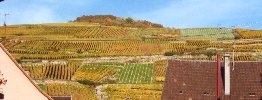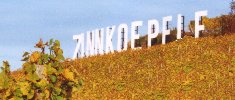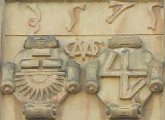|
|
||||||||||
|
||||||||||
|
|
||||||||||
|
|

|
The Noble Valley and the Zinnkoepflé mountain |
||||||||
|
|
Terroirs or georegions with a fine reputation since the Middle Ages Our description of the Noble Valley is taken from an article that appeared in the Format Raisin (summer 1996) based on the research of local historians.The Sun God was also the God of Springs in German mythology. According to the legend, the local people used to celebrate this God on the summit of the Zinnkpflé mountain, called Sonnenkoepflé, sun mountain, to thank him for the good things that he had brought to the valley. |
|||||||||
|
View of Zinnkoepflé mountain from Seppi Landmann's estate |
|
|||||||||
|
The towns of Westhalten and Soultzmatt first appeared in texts of the 11th century dealing with the vines in the region. At that time, these localities were part of the Obermundat area which had been granted to the Bishops of Strasbourg by King Dagobert to the great displeasure of of their rival, the Bishop of Basel who was in charge of the spiritual welfare of the followers of the Sun cult who feared the witches living on the Bollenberg hill opposite the Zinnkpflé mountain. However, the Bishop Princes were not only interested in the land, but also by more than 60 noble families who had settled in the valley over the centuries and given it the name of Vallis Praenobilis. Only one of the seven castles in Soultzmatt remains standing today, the Wagenbourg castle which is located near the Seppi Landmann estate. The old stone from the walls of the feudal buildings was used to pave the paths through the vineyards and make the terraces on the slopes of Mount Zinnkoepflé which had become the home of the old nobility. At the end of this closed Zinnkoepflé valley, called the Noble Valley, le Petit Ballon in the Vosges mountains acts as a barrier against the wind and rain that could disturb this Mediterranean climate in the valley. Whereas most of the Alsace vineyards face the Rhine river, Mount Zinnkpflé is in a sort of basin protected from the west winds and the summer storms. The rainfall is hardly 270 mm during the growing season and frosts are rare. This exceptional climate has turned the area into a garden of Eden. Here and there at the bottom of the valley, there are almond, lemon and orange trees in flower and up the slopes with their great classified growth there is flora similar to that of the shores of the Black Sea, the birth place of vine growing and wine making. A leader among the great classified growths (Grands crus) The Zinnkoepflé soil is made up of chalky limestone of the Muschelkalk period with sandstone inclusions giving delicate aromas and exceptional acidity which in their turn give unbelievable power and structure to the wine from this hillside. On these sun drenched slopes the vines face south south-east and flourish up to an altitude of 430m without being touched by the cold winds. Zinnkpflé wine is a leader among the great classified growths of Alsace and its slopes are where the grapes have no trouble reaching full maturity. The microclimate of the Noble Valley produces wines that are dry and flavorsome as well as the fabulous late harvest wines and noble rot sweet wines with the classified Zinnkoepflé first growth label (Grand Cru). Some exceptional years, the production of ice wine, which pushes the technical limitations of late harvesting to the extreme, is possible; the crop is left on the vines until the beginning of winter and the grapes are picked when the temperature drops to a minimium of 7°C and the grapes are frozen, hence the wines name. These characteristics associated with a winemakers passion delight the palate of those seeking the most authentic and unusual wines. |
||||||||||
| The Seppi Landmann estate | ||||||||||
|
Martin Kriegelstein's coat of arms
|
Seppi Landmanns winery is located 15km to the south of Colmar, in the village of Soultzmatt in the heart of the Noble Valley on the slopes of the Zinnkoepflé mountain. The year 1982 is important for the Noble Valley as this was the year that Seppi Landmann left the local cooperative, created his own winery and produced his first vintage. With just one hectare of vines as his only inheritance, a will of iron, an advanced wine technician's diploma in his pocket and his own ideas and experience of winemaking, he decided to devote all his time and energy to tending his vines and making and promoting his own wine. Today the estate has 8.5 hectares of vines located on the Zinnkoepflé and Bollenberg slopes as well as other hillsides in the Noble Valley. Seppi Landmann lives in a Renaissance home built in 1575 by a former Noble Valley Provost, Martin Kriegelstein, author of a chronicle called the "Thalbuch" which is an important document for the history of Soultzmatt. His coat of arms still decorates the facade overlooking the street. |
|||||||||
|
|
||||||||||



